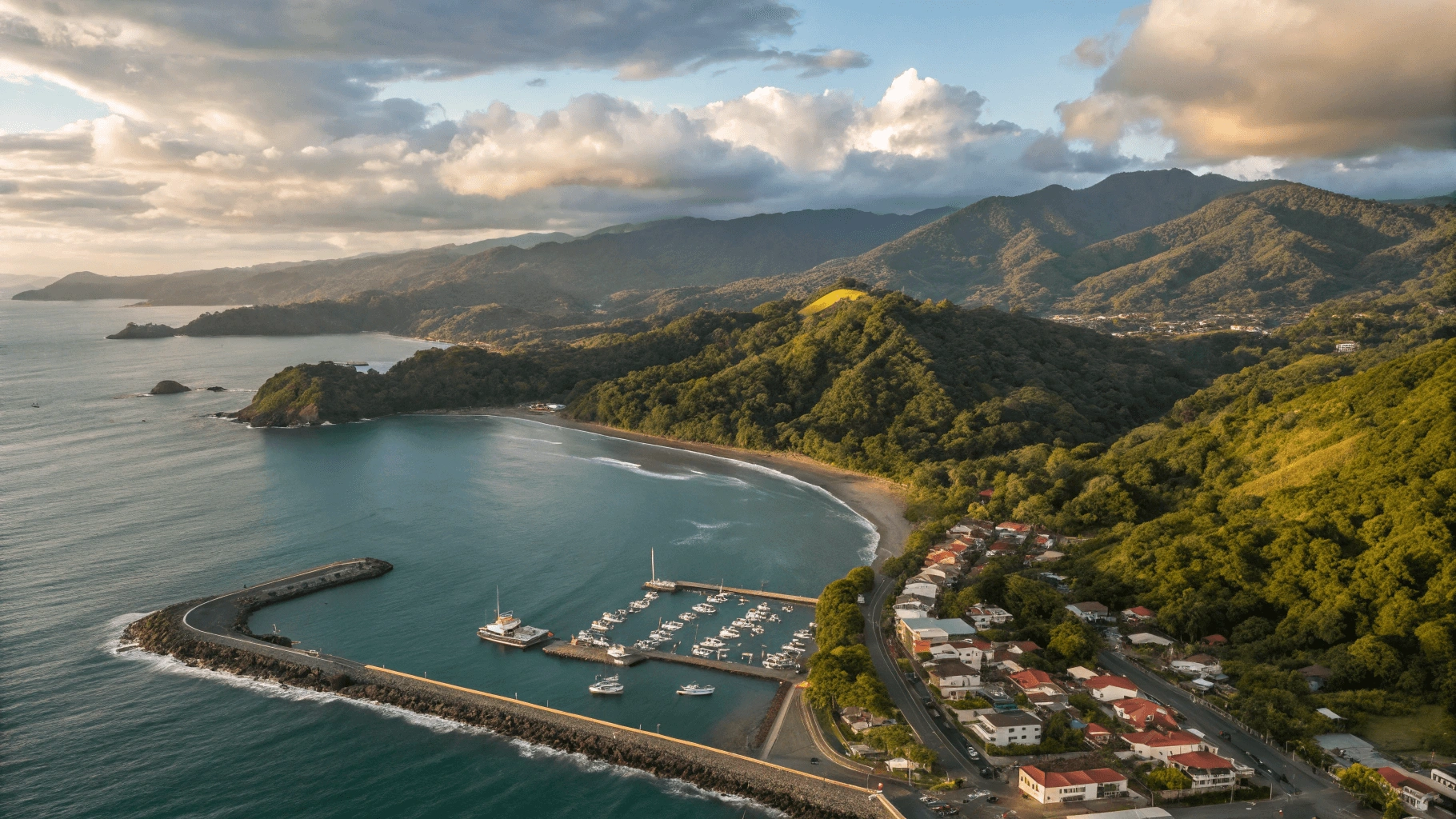Introduction
Nestled along Costa Rica’s stunning central Pacific coastline, Quepos has long been overshadowed by its famous neighbor, Manuel Antonio National Park. Yet this vibrant coastal town deserves recognition in its own right as a destination that perfectly balances natural wonders, adventure opportunities, and authentic Costa Rican culture.
Quepos offers travelers a unique blend of experiences: from world-class sportfishing in waters teeming with marlin and sailfish to jungle adventures where howler monkeys swing through the canopy overhead. Whether you’re seeking adrenaline-pumping activities, tranquil beaches, or immersion in pura vida culture, Quepos delivers with genuine charm and without the overwhelming tourism of other destinations.
This comprehensive guide will take you through everything you need to know about visiting quepos costa rica – from practical planning advice to hidden gems only locals know about. By the end, you’ll have all the information necessary to create an unforgettable Costa Rican adventure centered around this Pacific gem.
Table of Contents
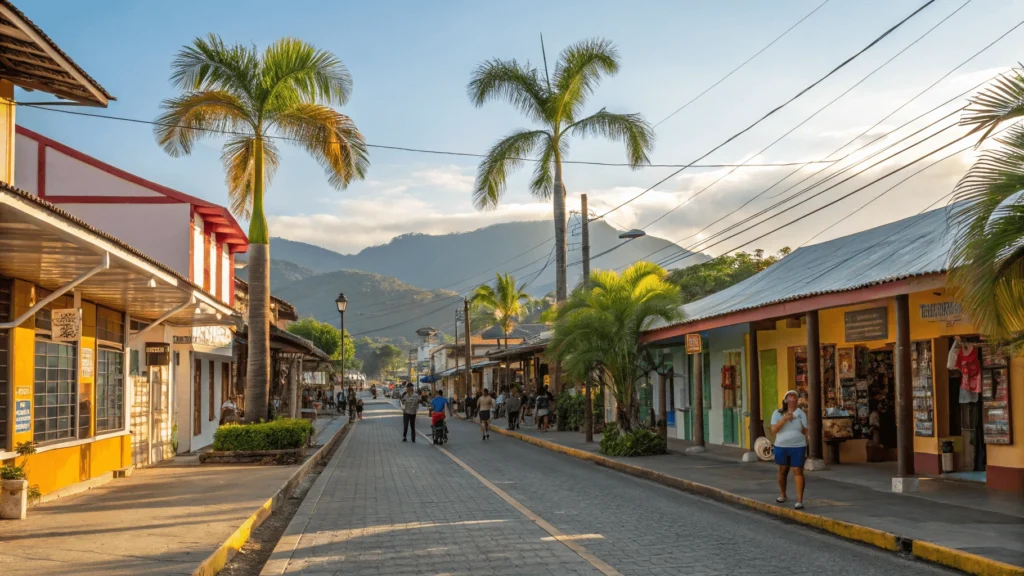
Quepos At-a-Glance
Quick Facts
| Information | Details |
|---|---|
| Location | Central Pacific Coast, Costa Rica |
| Province | Puntarenas |
| Currency | Costa Rican Colón (₡) |
| Languages | Spanish (official), English widely spoken in tourist areas |
| Time Zone | Central Standard Time (GMT-6) |
| Population | Approximately 22,000 |
| Climate | Tropical with distinct wet (May-November) and dry (December-April) seasons |
| Nearest Airport | Quepos La Managua Airport (XQP) for domestic flights; Juan Santamaría International Airport (SJO) for international flights |
| Best For | Sportfishing, wildlife watching, beaches, rainforest adventures |
Why Visit quepos costa rica?
- Gateway to Manuel Antonio National Park – One of Costa Rica’s most biodiverse protected areas
- World-renowned sportfishing – Often called the “Sailfish Capital of the World”
- Pristine beaches – Both within the park and along the surrounding coastline
- Rich wildlife viewing opportunities – Sloths, monkeys, toucans, and hundreds of bird species
- Variety of adventure activities – Ziplining, whitewater rafting, ATV tours, and more
- Authentic Costa Rican culture – Experience local life away from overly commercialized tourist zones
- Excellent dining scene – Fresh seafood and traditional Costa Rican cuisine
- Strategic location – Perfect base for exploring Costa Rica’s central Pacific region
Planning Your Trip
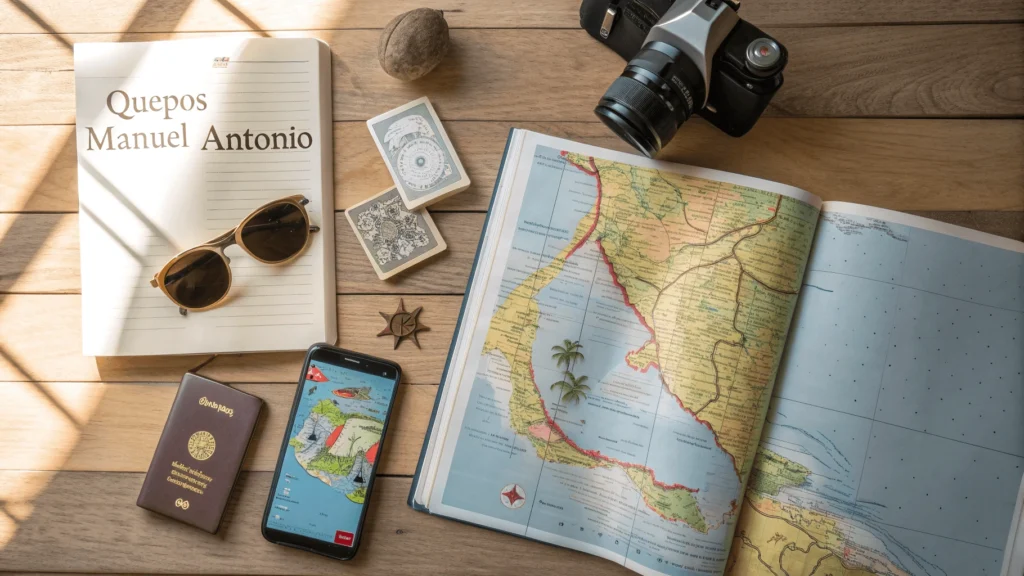
Best Time to Visit
quepos costa rica experiences two distinct seasons that dramatically affect your visit:
Dry Season (December-April)
- Weather: Sunny days with little rainfall and lower humidity
- Crowds: Peak tourist season, especially December-February and around Easter
- Advantages: Perfect beach weather, easier wildlife spotting, accessible trails
- Disadvantages: Higher prices, crowded attractions, advance reservations necessary
- Best for: Beach activities, hiking, photography
Green Season (May-November)
- Weather: Morning sunshine typically followed by afternoon showers; September-October see heaviest rainfall
- Crowds: Much fewer tourists, especially September-October
- Advantages: Lush landscapes, lower prices, fewer crowds
- Disadvantages: Some activities may be canceled during heavy rain; some roads may become difficult
- Best for: Budget travelers, waterfall viewing, rafting (higher water levels)
Fishing Seasons
- Sailfish: December-April (peak in January-March), For a full breakdown of Costa Rica’s fishing calendar by species, visit the official Costa Rica Tourism Board’s guide at https.
- Marlin: September-January
- Dorado (Mahi-Mahi): May-November
- Roosterfish: Year-round, best June-August
- Tuna: Year-round, peaks vary
Special Events
- Quepos Billfish Cup: February
- Festival del Mar: February (celebration of maritime culture)
- Independence Day: September 15 (nationwide celebrations)
Getting There
International Flights
Most international travelers arrive at Juan Santamaría International Airport (SJO) near San José or Daniel Oduber Quirós International Airport (LIR) in Liberia.
From San José to quepos costa rica
| Transportation | Time | Cost (USD) | Notes |
|---|---|---|---|
| Domestic Flight | 25 minutes | $70-120 one-way | Sansa Airlines or Aerobell to Quepos La Managua Airport |
| Rental Car | 3-3.5 hours | $50-80/day + fuel | Scenic drive via Highway 27 and Coastal Highway 34 |
| Shared Shuttle | 3.5-4 hours | $60-70 per person | Door-to-door service with scheduled departures |
| Private Transfer | 3-3.5 hours | $150-200 total | Customizable, comfortable option for families/groups |
| Public Bus | 4-5 hours | $8-10 | Regular service from Terminal Tracopa in San José |
From Liberia to quepos costa rica
- Rental Car: 4-4.5 hours via Coastal Highway
- Private Transfer: $220-280
- Public Transportation: Requires multiple connections, taking 6+ hours
Getting Around quepos costa rica
Local Transportation Options
- Public Buses: Regular service between Quepos and Manuel Antonio (approximately $0.75 each way), runs every 15-30 minutes during daylight hours
- Taxis: Readily available, expect $5-10 for most local trips
- Rental Cars: Several agencies in town, $50-80/day depending on vehicle type
- Bicycles: Available for rent at some hotels and shops, good for town exploration
- Walking: Quepos town center is compact and walkable
Transportation Tips
- Taxis should use meters (called “marias”) or agree on price beforehand
- For rental cars, 4WD is recommended if exploring beyond main roads
- During rainy season, expect occasional road flooding in low-lying areas
- The quepos costa rica-Manuel Antonio road can be steep and winding—consider public transport if uncomfortable driving
Accommodation
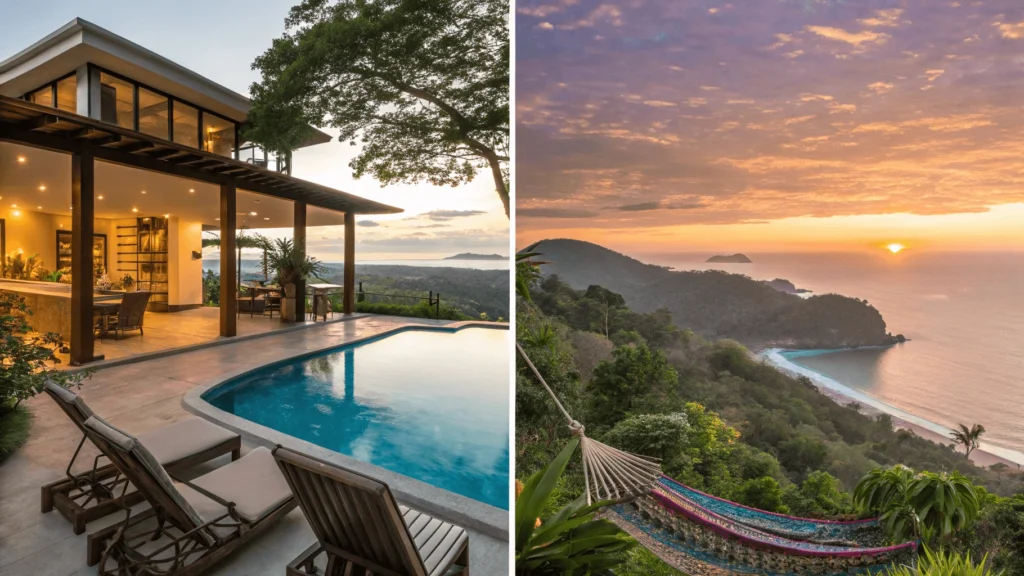
quepos costa rica offers lodging options for every budget and preference, from luxury resorts to backpacker hostels.
Luxury Options
- Arenas Del Mar: Beachfront eco-luxury resort with stunning ocean views
- Gaia Hotel & Reserve: Adults-only sanctuary with private nature reserve
- Los Altos Resort: Spacious apartment-style accommodations with ocean vistas
Mid-Range
- Hotel San Bada: Located at the entrance to Manuel Antonio National Park
- Hotel Vela Bar: Boutique hotel walking distance to beach
- Hotel La Mariposa: Panoramic views of the Pacific Ocean
Budget-Friendly
- Selina Hostel: Modern hostel with private and shared rooms
- Wide Mouth Frog Hostel: Popular backpacker spot in downtown quepos costa rica
- Hotel Kamuk: Historic hotel in central quepos costa rica with basic amenities
Vacation Rentals
- Numerous villas, apartments, and homes available through platforms like Airbnb and VRBO
- Best for families or longer stays
- Often provide better value and more space than hotels
Eco-Lodges
- Rafiki Safari Lodge: Safari-style tents in mountain setting
- Tulemar Bungalows: Set in 33-acre jungle reserve with private beach
Where to Stay
- Manuel Antonio: Closest to the national park, best views, higher prices
- Quepos Town: More authentic experience, lower prices, walking distance to markets and marina
- Hills Between: Jungle settings with wildlife viewing opportunities right from your balcony
- North of quepos costa rica: Quieter beaches, fewer tourists, more rural experience
Budgeting
| Expense Category | Budget | Mid-Range | Luxury |
|---|---|---|---|
| Accommodation | $20-50/night | $50-150/night | $150-500+/night |
| Meals | $5-15/meal | $15-30/meal | $30-60+/meal |
| Activities | $25-50/activity | $50-100/activity | $100-300+/activity |
| Transportation | Public bus: $1-3/day | Taxis: $15-30/day | Rental car: $50-80/day |
| Daily Total | $50-100/person | $150-300/person | $300-800+/person |
Money-Saving Tips
- Visit during green season (May-November) for significant discounts
- Eat at local “sodas” (small restaurants) for authentic, inexpensive meals
- Use public transportation between quepos costa rica and Manuel Antonio
- Book activities directly rather than through your hotel
- Consider vacation rentals for longer stays or group travel
Things to Do in quepos costa rica
Manuel Antonio National Park
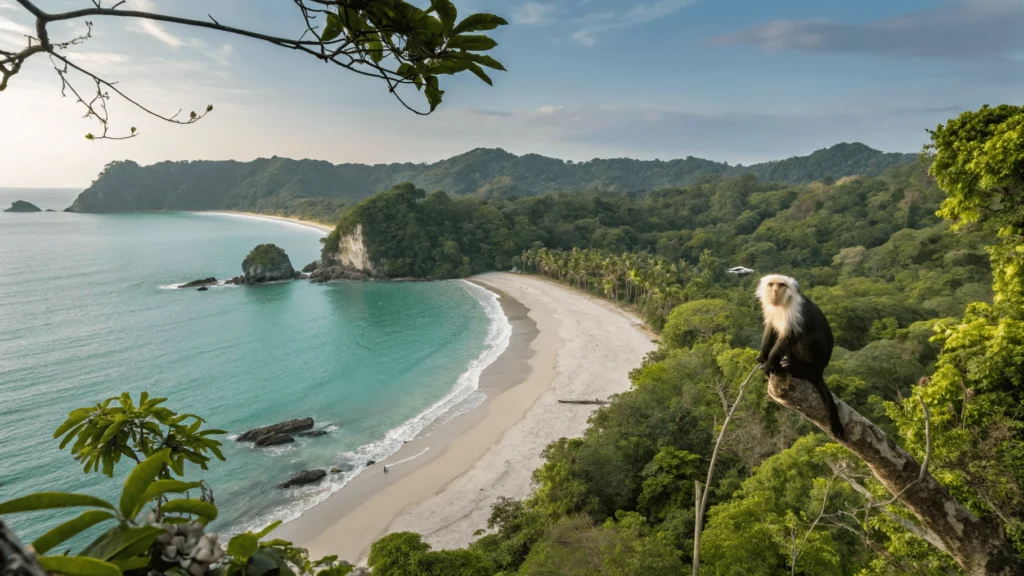
Though technically just outside quepos costa rica proper, Manuel Antonio National Park is the region’s crown jewel and a must-visit attraction. Despite being Costa Rica’s smallest national park, it packs incredible biodiversity into its 1,983 acres.
Essential Information
- Hours: Tuesday-Sunday, 7:00 AM – 4:00 PM (closed Mondays)
- Entrance Fee: $18 for foreign adults, $5 for children
- Best Time to Visit: Early morning (7:00-9:00 AM) for wildlife and before crowds arrive
- Required Time: 3-5 hours minimum
Getting Tickets
- Purchase tickets in advance through the official SINAC website
- Limited daily capacity means tickets often sell out, especially in high season
- Arrive early if buying tickets on-site
Hiring a Guide
- Professional guides cost $20-50 per person depending on group size
- Advantages: Spotting hidden wildlife, educational experience, skip ticket lines
- Self-guided option viable but you’ll miss many camouflaged animals
Top Trails
- Main Trail: Easy 1.3 mile path to beaches
- Cathedral Point Trail: Moderate difficulty with panoramic ocean views
- Sloth Trail: Easy path with high probability of sloth sightings
- Punta Serrucho Trail: More challenging hike with fewer crowds
Wildlife Spotting Tips
- Look up frequently—sloths and monkeys are often overhead
- Scan branches where they meet tree trunks—favorite sloth spots
- Listen for rustling leaves and distinctive calls
- Morning hours offer most active wildlife periods
- Bring binoculars for distant viewing
Park Beaches
- Manuel Antonio Beach: Picture-perfect crescent of white sand
- Espadilla Sur: Slightly larger beach with fewer people
- Playa Gemelas: Small, secluded pocket beach
- Playa Puerto Escondido: Tiny beach accessible only at low tide
Park Rules
- No food inside (except water and fruit)
- No feeding wildlife (hefty fines apply)
- No alcohol or smoking
- No removing anything from the park
- Stay on marked trails
Beaches
Beyond Manuel Antonio National Park, the quepos costa rica area boasts several excellent beaches worth exploring:
Playa Espadilla Norte
- Located just outside the park entrance
- Long stretch of beach with restaurants nearby
- Good for beginners’ surfing
- Swimming safe at most times (some rip currents)
- Sunset views are spectacular
Playa Biesanz
- Hidden gem reached by short jungle trail
- Calm protected waters ideal for swimming
- Natural shade from surrounding trees
- Less crowded than other beaches
- Occasional vendors selling coconuts and snacks
Playa La Macha
- Remote beach requiring guided access
- Pristine and undeveloped
- Strong currents (swimming not always recommended)
- Perfect for solitude seekers
Playa El Rey
- North of quepos costa rica
- Dark sand beach with few visitors
- Good for beach walks and shell collecting
- Limited facilities
Adventure Activities
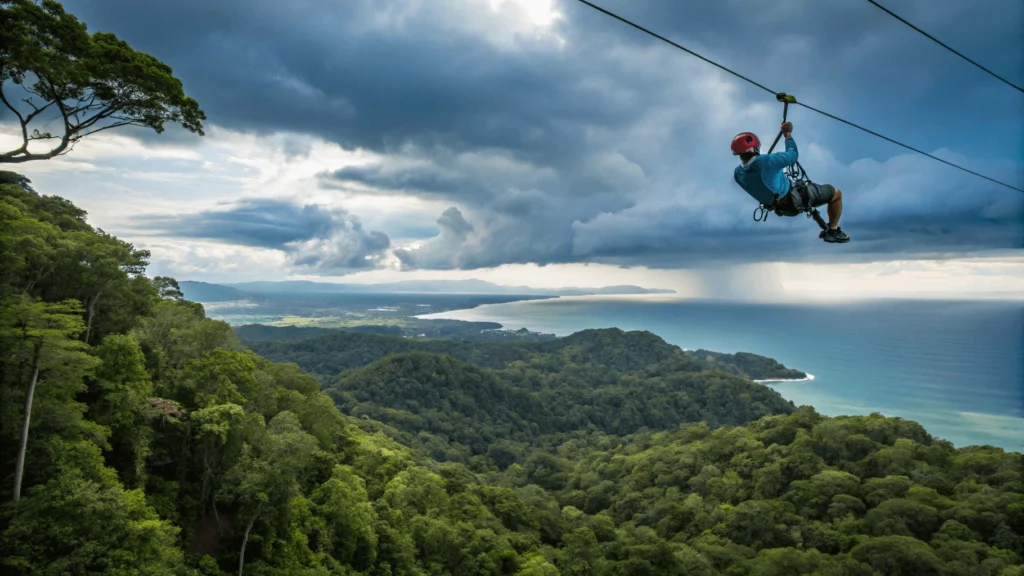
Quepos ranks among Costa Rica’s adventure capitals with numerous adrenaline-pumping activities:
Ziplining/Canopy Tours
- MidWorld Costa Rica: Features one of the longest ziplines in Central America
- El Santuario Canopy Adventure: Multiple ziplines through primary forest
- Titi Canopy Tour: Family-friendly option with 12 platforms
- Cost: $65-95 per person
Whitewater Rafting
- Naranjo River: Class III-IV rapids, best during rainy season
- Savegre River: Class II-III rapids, better for beginners
- Full-day tours: Include transportation, equipment, guide, and lunch
- Cost: $85-120 per person
Kayaking & Stand-Up Paddleboarding
- Mangrove tours: Peaceful exploration of Damas Island channels
- Ocean kayaking: Available at several beaches
- Cost: $45-75 for guided tours, $15-25 for rentals
ATV Tours
- Guided tours through mountains, jungle, and beaches
- Duration ranges from 2-4 hours
- Some include waterfall visits
- Cost: $75-120 per person
Surfing
- Playa Espadilla: Best for beginners with several surf schools
- Playitas: More challenging break for intermediate surfers
- Lessons: $45-60 for group lessons, $75-100 for private
- Board rentals: $10-20 per day
Parasailing
- Available from Manuel Antonio beach
- 15-minute flights offer breathtaking coastal views
- Cost: $70-90 per person
Wildlife & Nature (Beyond the Park)
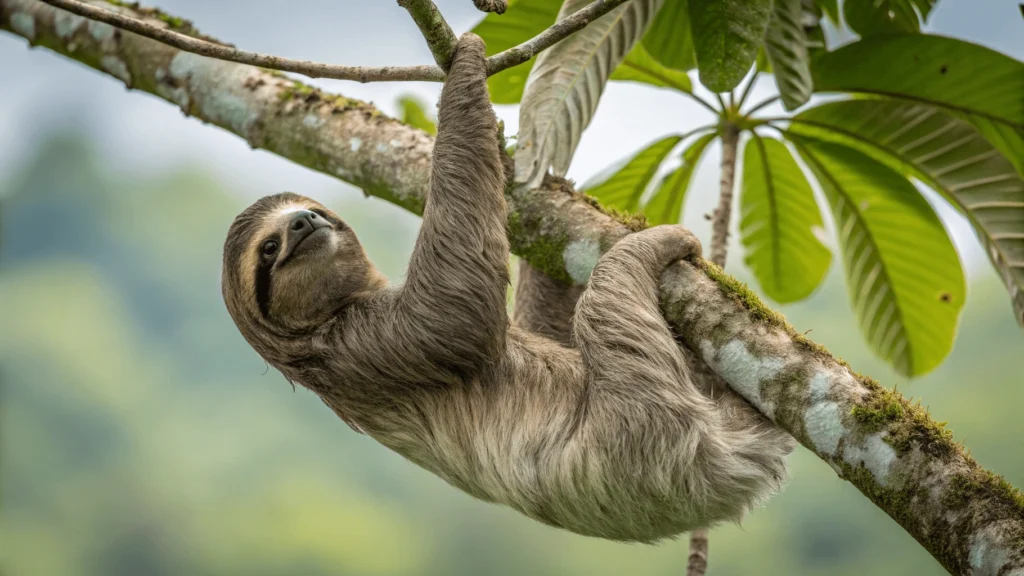
While Manuel Antonio gets most attention, several other natural areas around quepos costa rica offer exceptional wildlife experiences:
Damas Island Mangrove Tours , More on Costa Rica’s vital mangrove ecosystems is available from the Ramsar Convention on Wetlands at.
- Boat Tours: Quiet electric boats through mangrove channels
- Kayak Tours: More intimate exploration experience
- Wildlife: Sightings include silky anteaters, boas, monkeys, and numerous bird species
- Duration: 2-3 hours
- Cost: $60-80 boat, $50-70 kayak
Rainmaker Conservation Project
- Private reserve with suspended bridges
- Primary rainforest with waterfalls and natural pools
- Less crowded than Manuel Antonio
- Cost: $20 self-guided, $65-80 with transportation and guide
Night Tours
- Several operators offer guided nighttime wildlife walks
- Best for spotting frogs, insects, snakes, and nocturnal mammals
- Duration: 2 hours
- Cost: $40-60 per person
Bird Watching Hotspots
- Villa Vanilla Spice Farm: Combines bird watching with spice tour
- Esquipulas Rainforest: Known for toucans and parrots
- Manuel Antonio Road: Early morning viewing along hillsides
Wildlife Rescue Centers
- Kids Saving the Rainforest: Educational tours and rehabilitation center
- Cost: $60 for tour (proceeds support conservation)
Sportfishing
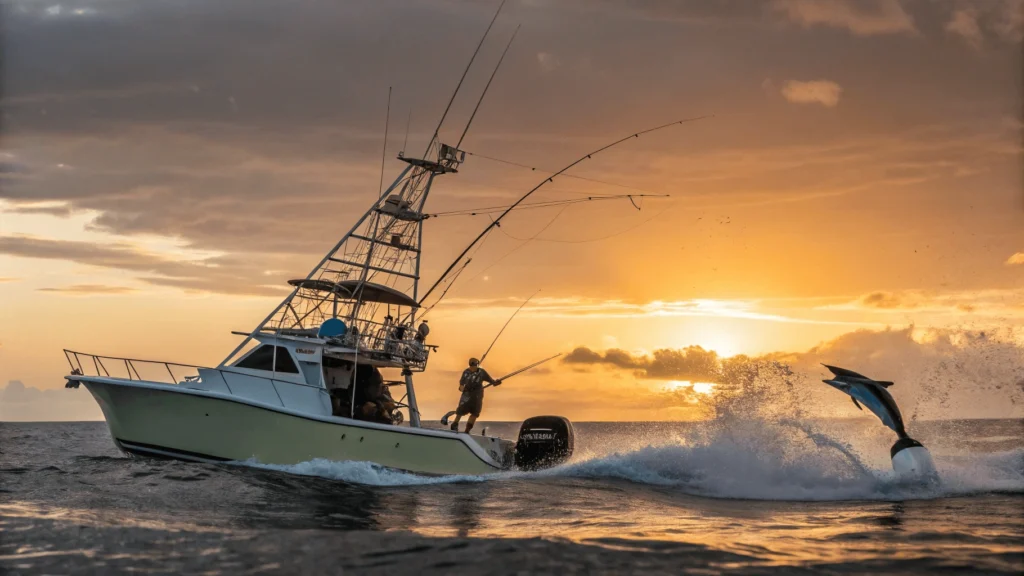
quepos costa rica has earned its reputation as a world-class fishing destination, particularly for sailfish and marlin. The area’s sportfishing industry is well-developed with professional captains and modern equipment.
Types of Fishing
- Offshore: 20+ miles out targeting sailfish, marlin, tuna, dorado
- Inshore: Along coastline for roosterfish, snapper, mackerel
- River Fishing: Freshwater options for snook and machaca
Best Seasons
- December-April: Peak sailfish season
- May-November: Excellent for dorado (mahi-mahi)
- September-January: Best for marlin
- Year-round: Roosterfish and snapper
Charter Types
- Luxury Sport Fishers: 31-50 feet, air-conditioned cabins, higher-end experience
- Center Consoles: 22-28 feet, faster, more affordable
- Half-Day: 5-6 hours, typically inshore
- Full-Day: 8-9 hours, allows reaching offshore grounds
- Multi-Day Packages: Discounted rates for multiple days
Costs
- Half-Day Inshore: $350-550 per boat (3-4 anglers)
- Full-Day Offshore: $850-1500 per boat (up to 6 anglers)
- Shared Charters: $175-300 per person for offshore trips
Marina Pez Vela
- Modern marina facility with 40+ charter operations
- Restaurants and shops on premises
- Regular fishing tournaments
- Boat rentals and water activities
Fishing Tips
- Book charters well in advance during high season
- All-inclusive packages often represent better value
- Catch-and-release is encouraged for billfish
- Licenses are included with charter bookings
Relaxation & Wellness
After adventure-filled days, quepos costa rica offers plenty of opportunities to unwind:
Spas
- Spa Uno: Full-service spa with ocean views
- Holis Wellness Center: Holistic treatments including ayurvedic options
- Si Como No Spa: Rainforest-inspired treatments
Yoga
- Holis Yoga Studio: Daily classes and retreats
- Yoga with Silvia: Beachfront morning sessions
- Blue Lotus Yoga: Drop-in classes for all levels
Hot Springs
- Villa Vanilla: Small natural hot springs on spice farm property
- Mid-Range Hotels: Several offer spa packages with hot tubs and steam rooms
Beaches for Relaxation
- Playa Biesanz: Calm waters in protected cove
- Manuel Antonio’s Third Beach: Quieter section with natural shade
Culture & Town Exploration
Quepos town itself offers cultural experiences and local color often missed by tourists rushing to Manuel Antonio:
quepos costa rica Malecón (Boardwalk)
- Recently renovated waterfront promenade
- Sunset views over the marina
- Local food vendors and performers in evenings
- Public park with exercise equipment
Farmers Market (Feria)
- Every Friday afternoon and Saturday morning
- Fresh produce, local crafts, and prepared foods
- Authentic Costa Rican social experience
- Located near the seawall
Marina Pez Vela
- Upscale shops and restaurants
- Watch fishing boats return with their catch
- Regular community events and music
- Weekly Sunset Marketplace with artisans (high season)
Cultural Experiences
- Villa Vanilla Spice Farm: Learn about organic spice production
- El Avión: Restaurant built around a C-123 Fairchild cargo plane with Iran-Contra history
- Local Art Galleries: Several showcase Costa Rican artists
Nightlife
While not as raucous as some beach destinations, quepos costa rica offers enjoyable evening entertainment:
Popular Bars
- Jolly Roger: Hillside location with sunset views and live music
- Byblos Resort & Casino: Gaming tables and ocean views
- Raphael’s Terrazas: Sophisticated cocktail spot with panoramic vistas
- Bar Tuanis: Local hangout with typical Costa Rican atmosphere
Live Music
- Selina Hostel: Regular events with local musicians
- Marina Pez Vela: Weekend performances in high season
- Bar Claro Que Sí: Dance floor with Latin music
Evening Activities
- Sunset Cruises: Departing from Marina Pez Vela
- Night Tours: Wildlife spotting after dark
- Cinema: Small theater occasionally showing English-language films
Food & Drink
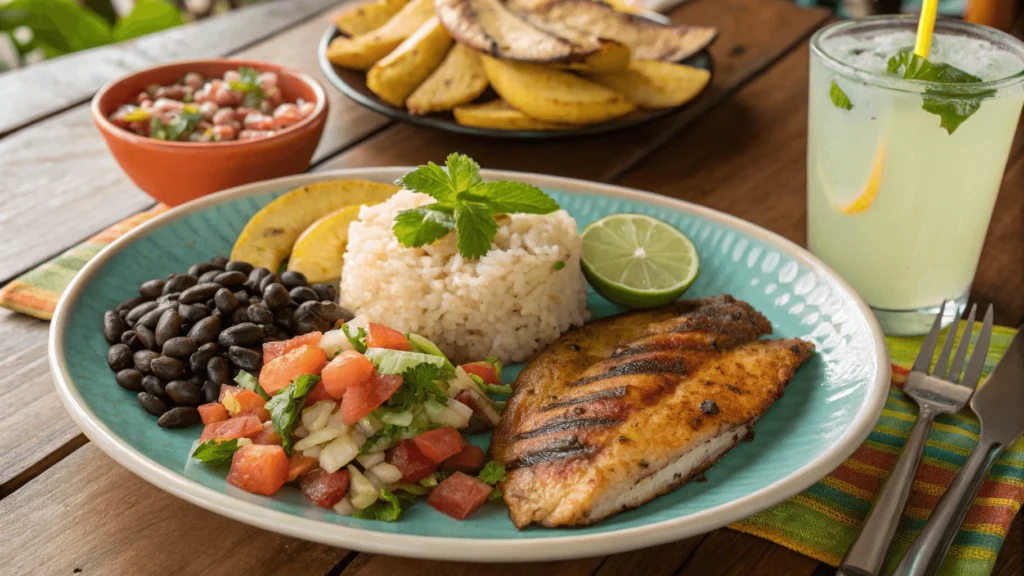
Costa Rican cuisine is flavorful, fresh, and heavily based on tropical fruits, rice, beans, and seafood. Quepos offers everything from humble local sodas to fine dining establishments.
Costa Rican Cuisine Highlights
Traditional Dishes
- Gallo Pinto: Rice and beans mixture, typically served at breakfast
- Casado: The typical lunch plate consisting of rice, beans, plantains, salad, and a protein
- Ceviche: Fresh raw fish marinated in citrus juice with onions, cilantro, and peppers
- Arroz con Pollo/Camarones: Rice with chicken or shrimp
- Patacones: Fried plantain discs, often served as appetizers
- Chifrijo: Layered dish of rice, beans, chicharrones, and pico de gallo
Local Specialties
- Fresh Seafood: The coastal location means excellent fish and shellfish
- Tropical Fruits: Mango, papaya, pineapple, and lesser-known fruits like cas, guanabana, and maracuyá
Recommended Restaurants
Local Sodas (Budget-Friendly)
- Soda Sánchez: Authentic Costa Rican food at reasonable prices
- Café Milagro: Coffee house with excellent breakfast options
- Soda Angel: Known for generous portions and fresh fish
Seafood Specialists
- Gabriella’s: Upscale seafood with creative preparation
- Sunrice Restaurant: Fresh catch with Asian influences
- Marlin Restaurant: Harbor-side dining with fishing fleet views
Fine Dining
- Emilio’s Café: Spectacular views and international cuisine
- Arbol Food & Wine: Contemporary dining in luxury setting
- Victoria’s: Italian-influenced menu with extensive wine list
International Options
- Z Gastro Bar: Fusion cuisine with Mediterranean influences
- El Avión: American-style menu in converted cargo plane
- Falafel Bar: Middle Eastern cuisine with vegetarian options
Cafés & Bakeries
- Baguette: French bakery with excellent pastries
- Brooklyn Bakery: New York-style bagels and coffee
- Rico Tico: Garden setting with Costa Rican coffee
Bars & Drinks
Local Beverages
- Imperial and Pilsen: Costa Rica’s national beers
- Cacique Guaro: Sugar cane liquor, basis for many cocktails
- Costa Rican Coffee: Local plantations produce excellent beans
- Natural Fruit Drinks (Refrescos): Made with water or milk (try horchata, cas, or guanabana)
Notable Drinking Spots
- Double Hook: Sports bar popular with fishing enthusiasts
- Barba Roja: Oldest restaurant in Manuel Antonio with sunset happy hour
- La Cantina: Live music and dancing
- Agua Azul: Spectacular views of the Pacific
Practical Information & Safety
Safety Tips
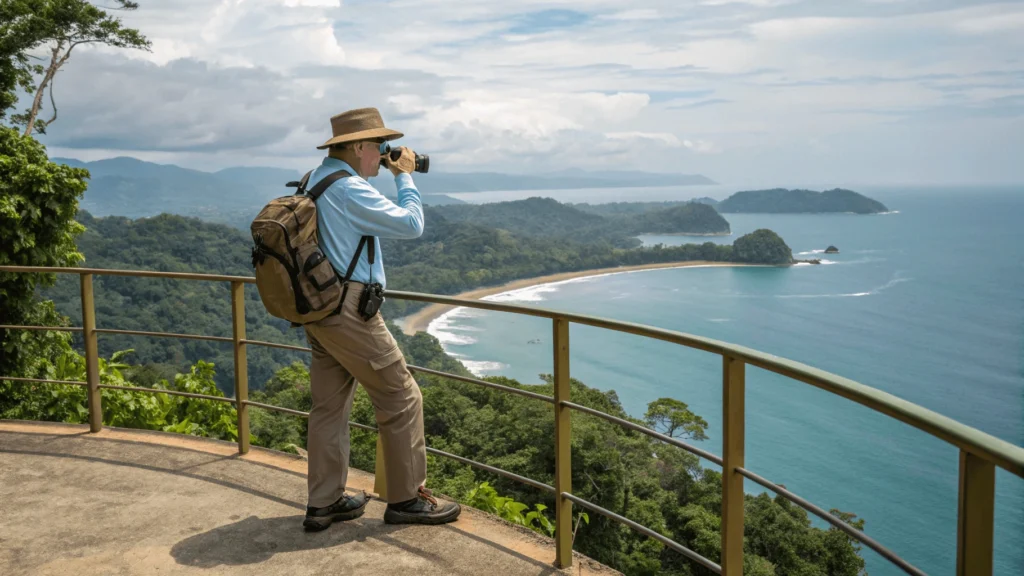
General Precautions
- Keep valuables secure and minimize jewelry display
- Use hotel safes for passports and extra cash
- Be cautious with ATM usage, preferring those in banks
- Lock vehicles and never leave belongings visible
Beach Safety
- Rip currents can be strong—observe warning flags
- Manuel Antonio has lifeguards; most other beaches don’t
- Apply reef-safe sunscreen frequently
- Guard belongings while swimming—theft can occur
Wildlife Safety
- Never feed the monkeys or other wildlife (illegal and dangerous)
- Keep distance from all animals, even seemingly docile ones
- Secure food in wildlife-proof containers
- Watch for falling coconuts under palm trees
Money & ATMs
- ATMs available in downtown Quepos and at Marina Pez Vela
- Major banks include BAC San José and Banco Nacional
- Credit cards widely accepted at established businesses
- Carry some cash for smaller vendors and rural areas
- US dollars accepted at many tourist establishments
Connectivity
- Good cell coverage in town and Manuel Antonio
- Most hotels and restaurants offer free WiFi
- Local SIM cards available from Kolbi, Movistar, and Claro
- Internet cafés available for those without devices
Health & Vaccinations
- No special vaccinations required beyond routine immunizations
- Bring insect repellent for mosquito protection
- Dengue fever and Zika present but uncommon
- Tap water generally safe in urban areas
- Medical facilities available in quepos costa rica for minor issues; serious conditions require travel to San José
- Travel insurance with medical coverage strongly recommended
Language Basics
While English is widely spoken in tourist areas, learning a few Spanish phrases enhances your experience:
- Hola – Hello
- Gracias – Thank you
- Por favor – Please
- ¿Cuánto cuesta? – How much does it cost?
- ¿Dónde está…? – Where is…?
- Mucho gusto – Nice to meet you
- Pura vida – Costa Rica’s motto meaning “pure life” (used as greeting, farewell, or expression of satisfaction)
Packing List Essentials
- Lightweight, quick-dry clothing
- Rain jacket or poncho (regardless of season)
- Insect repellent (30% DEET or higher)
- Reef-safe sunscreen
- Hiking shoes for trails
- Water shoes for beaches and boat trips
- Binoculars for wildlife viewing
- Waterproof bag for electronics
- Reusable water bottle
Beyond Quepos (Day Trips)
While quepos costa rica offers enough activities to fill a week or more, several worthwhile destinations make excellent day trips:
Dominical (45 minutes south)
- Laid-back surf town with consistent waves
- Hacienda Barú Wildlife Refuge with canopy tours
- Less developed than Manuel Antonio
- Popular with yogis and natural living enthusiasts
Uvita & Marino Ballena National Park (1 hour south)
- Famous “Whale’s Tail” sandbar formation
- Whale watching (July-October and December-March)
- Quieter beaches with fewer crowds
- Entrance fee: $6 per person
Nauyaca Waterfalls (1 hour southeast)
- Spectacular double-tiered waterfall
- Natural swimming pools
- Horseback riding tours available
- Entrance fee: $9 self-guided, $70 with horseback tour
Jaco (1 hour north)
- Larger beach town with shopping and nightlife
- Surf lessons and board rentals
- Carara National Park nearby (scarlet macaw sanctuary)
- More developed with greater amenity selection
Rainforest Aerial Tram (1.5 hours northeast)
- Tranquil gondola ride through rainforest canopy
- Butterfly garden and herpetarium
- Educational guided experience
- Cost: $65-80 per person
Frequently Asked Questions
Is Quepos worth visiting if I’ve already been to other parts of Costa Rica?
Absolutely! Quepos offers a unique combination of wildlife viewing, sportfishing, beaches, and adventure activities that differentiates it from other destinations. Its microclimate and biodiversity are distinct even within Costa Rica.
How many days should I spend in quepos costa rica?
A minimum of 3-4 days allows you to visit Manuel Antonio National Park, enjoy local beaches, and experience one or two adventure activities. A week or longer would permit more in-depth exploration including day trips to surrounding attractions.
Is Quepos safe for tourists?
Yes, Quepos is generally safe for tourists. Like most travel destinations, petty theft can occur, but violent crime against tourists is rare. Exercise normal precautions by securing valuables and being aware of your surroundings.
When is whale watching season in Quepos?
The best times for whale watching are July through October (humpback whales migrating from the south) and December through March (northern humpback migration). Tours depart from Marina Pez Vela.
Do I need a rental car in Quepos?
Not necessarily. Public transportation between Quepos and Manuel Antonio is frequent and affordable. Most tours include hotel pickup. However, a car provides flexibility for exploring more remote beaches and attractions at your own pace.
What’s the difference between staying in Quepos town versus Manuel Antonio?
Quepos town offers more local flavor, lower prices, and proximity to the marina and markets. Manuel Antonio provides better ocean views, closer access to the national park, and more upscale accommodations. Both areas are only 15 minutes apart by bus or car.
Is English widely spoken?
Yes, in tourist areas and establishments, English is commonly spoken. In more local settings or rural areas, basic Spanish is helpful but not essential.
Can I drink the tap water?
Tap water is generally safe in Quepos and Manuel Antonio. However, bottled water is readily available if you prefer, and some visitors choose this option particularly if they have sensitive stomachs.
What’s the best tour in Manuel Antonio National Park?
A guided tour with a knowledgeable naturalist makes a significant difference in spotting wildlife. Early morning tours (starting at park opening) offer the best wildlife viewing and cooler temperatures.
Is Quepos good for families with young children?
Absolutely! Many activities can be adapted for families, beaches like Playa Biesanz have calm waters, and children are typically fascinated by the easily visible wildlife. Several accommodations cater specifically to families with kids.
Conclusion
quepos costa rica represents the perfect balance of natural wonders, adventure opportunities, and authentic cultural experiences. While Manuel Antonio National Park deservedly captures attention, the entire region rewards travelers willing to explore beyond the famous park’s boundaries.
Whether you come for world-class sportfishing, to spot sloths hanging in cecropia trees, to zip through the rainforest canopy, or simply to relax on stunning beaches, Quepos delivers the quintessential Costa Rican experience. The town’s accessibility, developed tourism infrastructure, and stunning natural setting make it an ideal introduction to Costa Rica for first-time visitors while offering enough depth and diversity to satisfy returning travelers.
As you plan your visit to this Pacific paradise, remember that the true magic of quepos costa rica lies in its balance—between development and conservation, between adventure and relaxation, between tourist amenities and authentic local culture. Embrace the pura vida lifestyle, and let Quepos reveal its many treasures at the perfect tropical pace.

